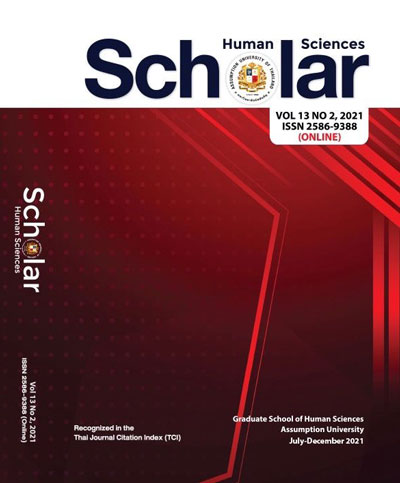A Comparative Study of Adult Learners’ Motivation for Learning English as a Foreign Language According to Their Instruction by Single or Multiple Instructors at Geos Language Centre, Thailand
Keywords:
Adult Learners, Motivation for Learning, English as a Foreign Language, Single Instructors, Multiple Instructors, ThailandAbstract
The purpose of this quantitative study was to compare adult learners’ motivation for learning English as a foreign language according to their instruction by either a single instructor or by multiple instructors over a period of six weeks at Geos Language Centre in Bangkok, Thailand. The sample population of this study consisted of 67 adult-learner students enrolled in private English as a foreign language courses during the period of April to July 2020. These students comprised two groups under investigation during the period of this study: 1) Those who received instruction from a single instructor, and 2) Those who received instruction from multiple instructors. The Questionnaire for Measuring Motivation for Learning English as a Foreign Language (QMMLEFL), adapted from the Attitude / Motivation Test Battery (AMTB) by Gardner (2004), was used to measure the level of adult learners’ motivation for learning English as a foreign language (EFL). Descriptive statistics (means and standard deviations) were calculated, and statistical hypothesis testing (comparative analysis using paired samples t-tests and an independent samples t-test) was performed from data collected to pursue the research objectives and accept or reject the research hypotheses of this study. The research findings did not indicate that there was a statistically significant difference in the gain in motivation for learning English as a foreign language over a six-week period of study between adult learners who studied with a single instructor and adult learners who studied with multiple instructors. Recommendations for adult learners and instructors of English as a foreign language and language institute administrators and future researchers are provided.
References
Dörnyei, Z. (2001). Motivational strategies in the language classroom. Cambridge: Cambridge University Press. http://dx.doi.org/10.1017/CBO9780511667343Frymier, A. B. and Houser, M. L. (2000) The Teacher-Student Relationship as an Interpersonal Relationship. Communication Education Vol. 49, No. 3. Pp. 207 - 2019.
Gardner, R. C. (1985a). The Attitude Motivation Test Battery: Technical report 1985. Retrieved from http://publish.uwo.ca/~gardner/docs/AMTBmanual.pdf
Gardner, R. C. (1985b). Social psychology and second language learning: The role of attitudes and motivation. London: Edward Arnold Ltd. Retrieved from http://publish.uwo.ca/~gardner/docs/SECONDLANGUAGE1985 book.pdf
Gardner, R. C. (2004). Attitude/Motivation Exam Battery: International AMTB research project. Canada: The University of Western Ontario. Retrieved from https://pdfs.semanticscholar.org/043b/4389a9fa5acf303c6280fb218da 4ddff1ee4.pdf
Gardner, R. C. (2010). Motivation and second language acquisition: The socio-educational model. New York: Peter Lang.
Lederman, D. (2018). Who is studying online (and Where): Inside higher Ed. Retrieved from https://www.insidehighered.com/digital-learning/article/2018/01/05/new-us-data-show-continued-growth-college-students-studying
Richards, J. C. (2006). Communicative language teaching today, Cambridge University Press.
Velez, J. J., and Cano, J. (2008) The Relationship between Teacher Immediacy and Student Motivation. Journal of Agricultural Education, Volume 49, Number 3, 2008.
Yunus, M. M., Osman, W. S. W., & Ishak, N. M. (2011). Teacher-student relationship factor affecting motivation and academic achievement in ESL classroom. Procedia Social and Behavioral Sciences, 15(2011), 2637-2641.




